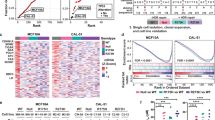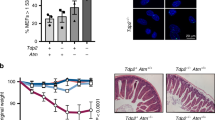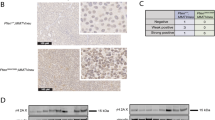Abstract
Tp53 is the most commonly mutated tumour-suppressor gene in human cancers1. In addition to the loss of tumour-suppression function, some missense mutants gain novel oncogenic activities2. To elucidate the nature of the gain of function, we introduced the most common p53 cancer mutations (R248W and R273H) independently into the humanized p53 knock-in (HUPKI) allele in mice. Tumour-suppressor functions of p53 are abolished in p53-mutant mice. Several lines of evidence further indicate gain-of-function of p53 mutants in promoting tumorigenesis. p53R248W mice rapidly succumb to certain types of cancers not commonly observed in p53−/− mice. Interchromosomal translocations, a type of genetic instability rarely observed in p53−/− cells, are readily detectable in p53-mutant pre-tumor thymocytes. Although normal in p53−/− mouse cells, the G2–M checkpoint is impaired in p53-mutant cells after DNA damage. These acquired oncogenic properties of mutant p53 could be explained by the findings that these p53 mutants interact with the nuclease Mre11 and suppress the binding of the Mre11–Rad50–NBS1 (MRN) complex to DNA double-stranded breaks (DSBs), leading to impaired Ataxia-telangiectasia mutated (ATM) activation. Therefore, p53 gain-of-function mutants promote tumorigenesis by a novel mechanism involving active disruption of critical DNA damage-response pathways.
This is a preview of subscription content, access via your institution
Access options
Subscribe to this journal
Receive 12 print issues and online access
$209.00 per year
only $17.42 per issue
Buy this article
- Purchase on Springer Link
- Instant access to full article PDF
Prices may be subject to local taxes which are calculated during checkout





Similar content being viewed by others
References
Hollstein, M., Sidransky, D., Vogelstein, B. & Harris, C. C. p53 mutations in human cancers. Science 253, 49–53 (1991).
Sigal, A. & Rotter, V. Oncogenic mutations of the p53 tumor suppressor: the demons of the guardian of the genome. Cancer Res. 60, 6788–6793 (2000).
Gudkov, A. Microarray analysis of p53-mediated transcription: multi-thousand piece puzzle or invitation to collective thinking. Cancer Biol. Ther. 2, 444–445 (2003).
Murphy, M. E. The thousand doors that lead to death: p53-dependent repression and apoptosis. Cancer Biol. Ther. 2, 381–382 (2003).
Lin, T. et al. p53 induces differentiation of mouse embryonic stem cells by suppressing Nanog expression. Nature Cell Biol. 7, 165–171 (2005).
Xu, Y. A new role for p53 in maintaining genetic stability in embryonic stem cells, Cell Cycle 4, 363–364 (2005).
Hainaut, P. & Hollstein, M. p53 and human cancer: the first ten thousand mutations. Adv. Cancer Res. 77, 81–137 (2000).
Luo, J. L. et al. Knock-in mice with a chimeric human/murine p53 gene develop normally and show wild-type p53 responses to DNA damaging agents: a new biomedical research tool. Oncogene 20, 320–328 (2001).
Feng, L., Hollstein, M. & Xu, Y. Ser46 phosphorylation regulates p53-dependent apoptosis and replicative senescence. Cell Cycle 5, 2812–2819 (2006).
Hergenhahn, M., Luo, J. L. & Hollstein, M. p53 designer genes for the modern mouse. Cell Cycle 3, 738–741 (2004).
Ben-Porath, I. & Weinberg, R. A. The signals and pathways activating cellular senescence, Int. J. Biochem. Cell Biol. 37, 961–976 (2005).
Olive, K. P. et al. Mutant p53 gain of function in two mouse models of Li-Fraumeni syndrome. Cell 119, 847–860 (2004).
Liao, M. J. et al. No requirement for V(D)J recombination in p53-deficient thymic lymphoma. Mol Cell Biol 18, 3495–3501 (1998).
Bassing, C. H. et al. Histone H2AX: a dosage-dependent suppressor of oncogenic translocations and tumors. Cell 114, 359–370 (2003).
Lista, F., Bertness, V., Guidos, C. J., Danska, J. S. & Kirsch, I. R. The absolute number of trans-rearrangements between the TCRG and TCRB loci is predictive of lymphoma risk: a severe combined immune deficiency (SCID) murine model. Cancer Res. 57, 4408–4413 (1997).
Kang, J., Bronson, R. T. & Xu, Y. Targeted disruption of NBS1 reveals its roles in mouse development and DNA repair. EMBO J. 21, 1447–1455 (2002).
Shiloh, Y. ATM and related protein kinases: safeguarding genome integrity. Nature Rev. Cancer 3, 155–168 (2003).
Xu, Y. et al. Targeted disruption of ATM leads to growth retardation, chromosomal fragmentation during meiosis, immune defects, and thymic lymphoma. Genes Dev. 10, 2411–2422 (1996).
Barlow, C. et al. Atm-deficient mice: a paradigm of ataxia telangiectasia. Cell 86, 159–171 (1996).
Bakkenist, C. J. & Kastan, M. B. DNA damage activates ATM through intermolecular autophosphorylation and dimer dissociation. Nature 421, 499–506 (2003).
Xu, Y. DNA damage: a trigger of innate immunity but a requirement for adaptive immune homeostasis. Nature Rev. Immunol. 24, 261–270 (2006).
Fernandez-Capetillo, O. et al. DNA damage-induced G2–M checkpoint activation by histone H2AX and 53BP1. Nature Cell Biol. 4, 993–997 (2002).
Kang, J. et al. Functional interaction of H2AX, NBS1, and p53 in ATM-dependent DNA damage responses and tumor suppression. Mol. Cell Biol. 25, 661–670 (2005).
Falck, J., Coates, J. & Jackson, S. P. Conserved modes of recruitment of ATM, ATR and DNA-PKcs to sites of DNA damage. Nature 434, 605–611 (2005).
You, Z., Chahwan, C., Bailis, J., Hunter, T. & Russell, P. ATM activation and its recruitment to damaged DNA require binding to the C terminus of Nbs1. Mol. Cell Biol. 25, 5363–5379 (2005).
Lee, J. H. & Paull, T. T. ATM activation by DNA double-strand breaks through the Mre11–Rad50–Nbs1 complex. Science 308, 551–554 (2005).
Gaiddon, C., Lokshin, M., Ahn, J., Zhang, T. & Prives, C. A subset of tumor-derived mutant forms of p53 down-regulate p63 and p73 through a direct interaction with the p53 core domain. Mol. Cell Biol. 21, 1874–1887 (2001).
Lang, G. A. et al. Gain of function of a p53 hot spot mutation in a mouse model of Li-Fraumeni syndrome. Cell 119, 861–872 (2004).
Assenmacher, N. & Hopfner, K. P. MRE11/RAD50/NBS1: complex activities. Chromosoma 113, 157–166 (2004).
Chao, C. et al. Cell type- and promoter-specific roles of Ser18 phosphorylation in regulating p53 responses. J. Biol. Chem. 278, 41028–41033 (2003).
Acknowledgements
We thank J. Earle, L. Feng, J. Kang and Z. Wu for technical support, J. Petrini for anti-mouse Mre11 antibodies and R. Brachmann for critically reading the manuscript. This work was supported by a Department of Defense Prostate Cancer Research Program (W81XWH-05-1-0006) prostate cancer research grant and a National Institute of Health (NIH) grant (CA77563) to Y.X.
Author information
Authors and Affiliations
Corresponding author
Ethics declarations
Competing interests
The authors declare no competing financial interests.
Supplementary information
Supplementary Information
Supplementary Figures S1, S2, S3, S4 (PDF 1884 kb)
Rights and permissions
About this article
Cite this article
Song, H., Hollstein, M. & Xu, Y. p53 gain-of-function cancer mutants induce genetic instability by inactivating ATM. Nat Cell Biol 9, 573–580 (2007). https://doi.org/10.1038/ncb1571
Received:
Accepted:
Published:
Issue Date:
DOI: https://doi.org/10.1038/ncb1571
This article is cited by
-
A novel targeted NGS panel identifies numerous homologous recombination deficiency (HRD)-associated gene mutations in addition to known BRCA mutations
Diagnostic Pathology (2024)
-
Mining cancer genomes for change-of-metabolic-function mutations
Communications Biology (2023)
-
USP19 Negatively Regulates p53 and Promotes Cervical Cancer Progression
Molecular Biotechnology (2023)
-
Li–Fraumeni syndrome in Tunisian carriers with different and rare tumor phenotype: genotype–phenotype correlation
BMC Medical Genomics (2022)
-
A unique role of p53 haploinsufficiency or loss in the development of acute myeloid leukemia with FLT3-ITD mutation
Leukemia (2022)



